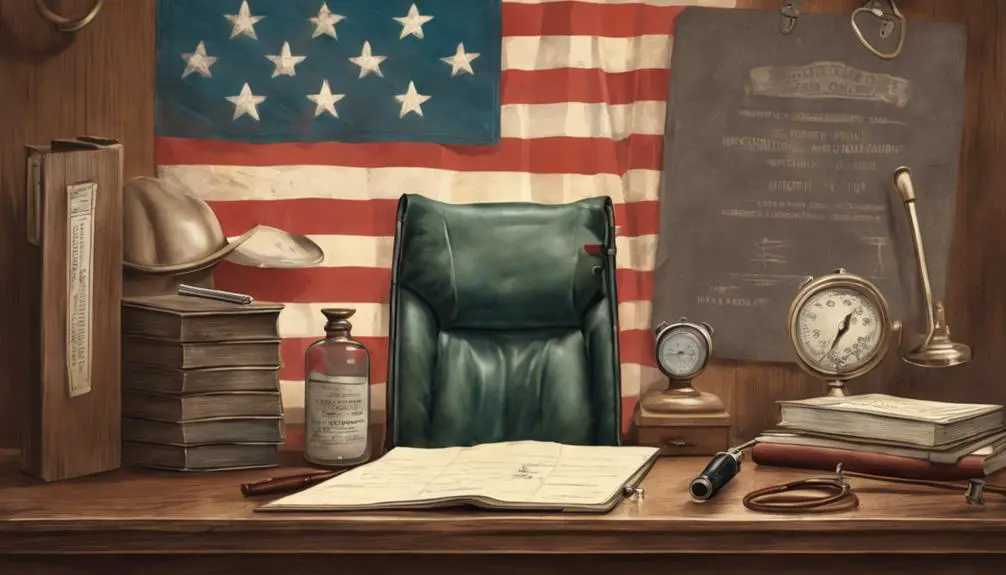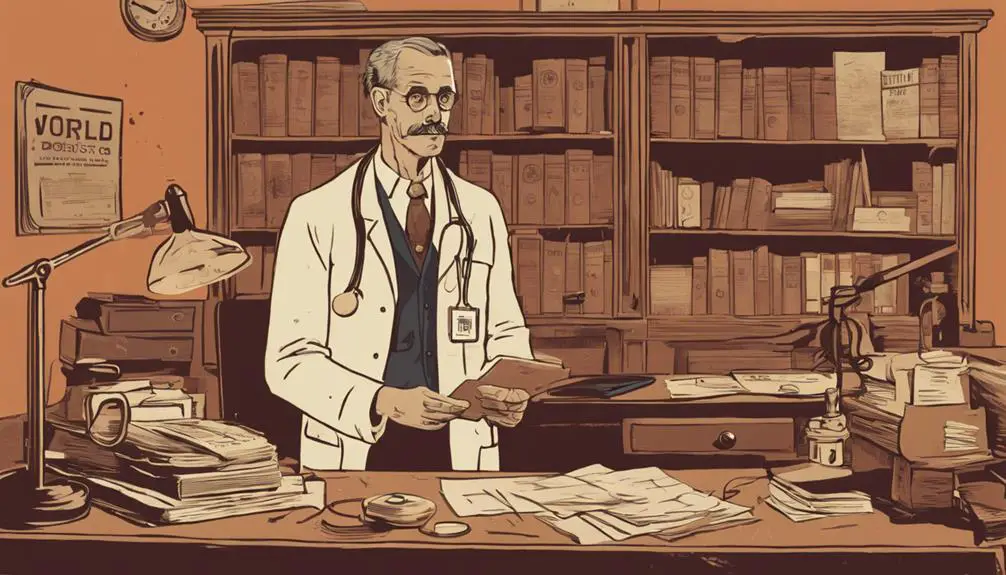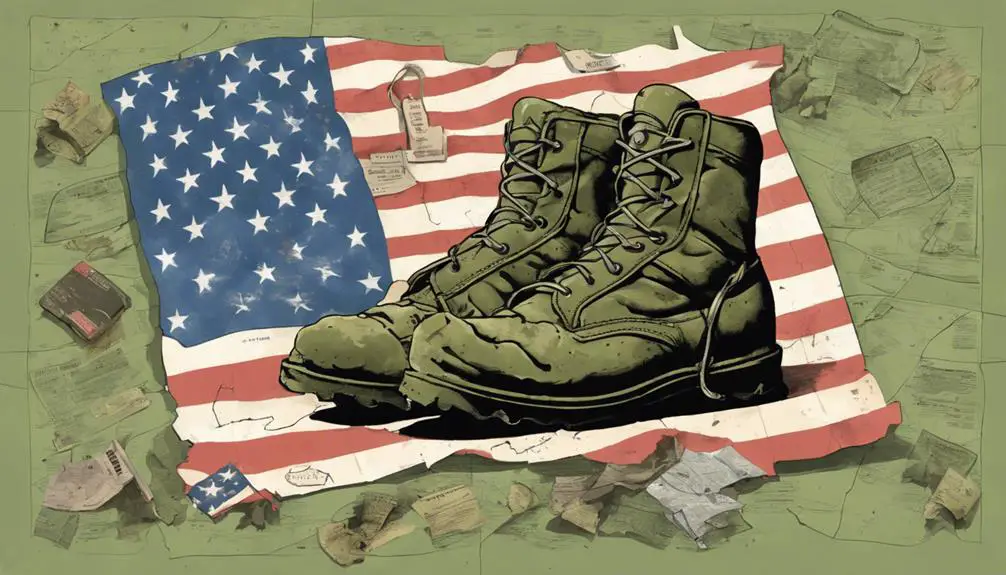When you hear "4F" in military slang, you're likely referring to a classification that indicates you're unfit for service. This label originated in World War I, categorizing recruits based on physical and mental fitness. Today, it encompasses broader exemptions, including medical conditions and societal attitudes. You might be surprised to learn that being 4F can impact not only military service but also civilian life, influencing employment, education, and healthcare. And, despite the stigma, many 4F individuals have achieved remarkable success in various fields. There's more to the story of 4F than meets the eye – and there's still more to uncover.
Origins of the 4F Classification

What inspired the creation of the 4F classification, a term that would become synonymous with ineligibility for military service? You might be surprised to learn that it dates back to World War I. During this time, the US military needed a system to categorize potential recruits based on their physical and mental fitness. The 4F classification was born, indicating that an individual was unfit for service due to various reasons.
You might've received a draft deferment or been granted medical exemptions, but what does it really mean to be 4F? In the past, it meant that you didn't meet the military's strict physical and mental standards. This could be due to various medical conditions, such as flat feet, poor eyesight, or even mental health issues. The classification system helped to streamline the enlistment process, ensuring that only the most capable individuals were accepted into the military.
Today, the 4F classification remains an important part of military history. While the classification system has evolved over time, its origins are rooted in the need for a standardized way to evaluate potential recruits. By understanding the origins of 4F, you'll gain a deeper appreciation for the complexities of military service.
What Does 4F Mean Today
As you navigate the modern military landscape, you'll find that the 4F classification has evolved to encompass a broader range of exemptions, reflecting advancements in medical understanding and shifting societal attitudes towards mental health.
| Category | Modern Implications | Civilian Applications |
|---|---|---|
| Physical Health | Certain medical conditions, such as asthma or diabetes, may exempt individuals from service. | Employers may accommodate employees with similar conditions under the Americans with Disabilities Act. |
| Mental Health | Conditions like anxiety or depression may qualify for a 4F classification. | Civilian organizations prioritize mental health support, mirroring the military's evolving stance. |
| Cognitive Ability | Certain cognitive or learning disabilities may disqualify individuals from service. | Civilian educational institutions and workplaces provide accommodations for individuals with similar disabilities. |
| Moral Character | Certain criminal offenses or behavioral issues may lead to a 4F classification. | Civilian employers consider an individual's moral character during the hiring process. |
| Administrative | Administrative reasons, such as a surplus of personnel, may also lead to a 4F classification. | Civilian organizations may downsize or restructure, resulting in similar classifications. |
Today, the 4F classification has modern implications that extend beyond the military sphere, influencing civilian applications in employment, education, and healthcare.
Historical Context of 4F

During World War I, the US military introduced the 4F classification to denote individuals deemed unfit for service, sparking a century-long evolution of exemptions that would eventually influence civilian life.
You might wonder, what was the historical context that led to this classification? As you explore the history, you'll find that war efforts during World War I required massive mobilization, leading to rationing consequences that affected the entire nation.
The social attitudes of the time viewed military service as a patriotic duty, and those who didn't serve were often stigmatized as draft dodgers. The economic burden of the war effort was substantial, and public opinion was heavily influenced by propaganda campaigns that emphasized the importance of military service.
The 4F classification was born out of this context, as the military needed a way to categorize those who were unfit to serve. This classification would go on to have a lasting impact on civilian life, shaping social attitudes and influencing public opinion for generations to come.
Medical Standards for 4F
You'll encounter a range of medical standards that determine 4F classification, from vision and hearing impairments to physical deformities and chronic health conditions. These standards are in place to guarantee that individuals are physically and mentally capable of serving in the military. If you're deemed 4F, it means you don't meet these standards.
| Medical Condition | Disability Percentage |
|---|---|
| Loss of limb | 80-100% |
| Severe PTSD | 50-70% |
| Chronic back pain | 30-50% |
In some cases, medical waivers can be granted, allowing individuals with certain conditions to still serve. However, these waivers are typically only granted for conditions that don't significantly impact an individual's ability to perform their duties. Disability percentages, like those listed above, are used to determine the level of compensation and benefits an individual is eligible for. Understanding these medical standards and disability percentages is essential for individuals who are considering a career in the military.
Impact on Military Service

Military service is greatly affected when an individual is deemed 4F, as it disqualifies them from serving in the military, limiting their career options and opportunities. You may have had your heart set on a military career, but now you're forced to explore alternative paths. This can be a significant blow to your morale, especially if you've always dreamed of serving your country.
However, it's vital to remember that being 4F doesn't define your worth or capabilities. You can still contribute to your community and country in other ways. You might consider volunteering, working in the public sector, or pursuing a career in a related field. In fact, many 4F individuals have gone on to achieve great things in their chosen fields.
Effective communication is important in the military, and language barriers can be a significant obstacle. When you're unable to communicate effectively, it can be a significant morale boost to find alternative ways to connect with your comrades. By adapting to new circumstances and finding ways to overcome language barriers, you can still make a meaningful impact, even if it's not in a traditional military capacity.
Famous 4F Cases in History
History is replete with notable individuals who, despite being deemed 4F, went on to achieve remarkable success in their respective fields, their stories serving as a confirmation of the power of perseverance and determination. You might be surprised to learn that some of the most iconic figures in history were initially deemed unfit for military service.
Some notable examples include:
- Elvis Presley: The King of Rock 'n' Roll was classified 4F due to his poor vision. Instead of serving, he focused on his music career, becoming one of the most influential musicians of all time.
- Steve Jobs: Co-founder of Apple, Jobs was deemed 4F due to his health issues. He went on to revolutionize the tech industry, leaving a lasting legacy.
- Ted Turner: The media mogul was classified 4F due to his dyslexia. He didn't let that hold him back, building a media empire and becoming a celebrated philanthropist.
These cases prove that being labeled 4F doesn't define one's potential. In fact, some of the most successful individuals in history were initially deemed unfit for service, including celebrity exemptions and draft dodgers. Despite the initial setback, they persevered and achieved greatness.
Evolution of 4F Over Time

Over the decades, the 4F classification has undergone significant changes, adapting to shifting societal attitudes and medical advancements that have redefined what it means to be fit for service.
You might be surprised to learn that the 4F classification was initially used to disqualify individuals with physical or mental disabilities, but it has since evolved to become more inclusive.
As cultural attitudes towards disabilities have shifted, the military has adapted its standards to accommodate individuals with disabilities. This evolution has significant cultural significance, as it reflects a broader societal shift towards greater inclusivity and acceptance.
The historical legacy of the 4F classification is one of adaptation and growth, as the military has worked to balance the need for a strong fighting force with the importance of inclusivity and equal opportunity.
Today, the 4F classification is no longer a source of shame, but rather a recognition of the complexities of human health and the importance of individualized assessment.
Frequently Asked Questions
Can 4F Classification Be Appealed or Changed?
If you're wondering if a 4F classification can be appealed or changed, the answer is yes. But be prepared for a tough battle.
You'll need to invest time and effort into mental preparation, gathering evidence and building a strong case.
Be ready to navigate administrative hurdles, too. It won't be easy, but with persistence and the right strategy, you can potentially appeal or change your classification.
Is 4F Only Limited to Physical Health Issues?
You think a 4F classification is only about physical health issues? Think again. The truth is, it's not just about physical limitations.
Mental health can also play a role in determining your eligibility for military service. In fact, moral waivers can even be granted for certain psychological conditions.
Are 4F Individuals Still Considered Veterans?
You might wonder if 4F individuals, deemed unfit for military duty, are still considered veterans. The answer is yes. Although they didn't serve, they attempted to enlist, showcasing their willingness to serve. This earns them veteran pride and Service recognition.
You should acknowledge their efforts, as they demonstrated patriotism and a desire to contribute to their country's defense.
Can 4F Individuals Still Serve in Non-Combat Roles?
Don't assume you're out of options just because you're 4F. You might still have a place in the military.
While combat roles are off the table, you can still serve in support roles or desk jobs. You'll find opportunities in administration, logistics, or intelligence, where your skills can make a difference.
You can contribute to the military's mission without being on the front lines.
Do Other Countries Have Similar Classifications to 4f?
You're wondering if other countries have similar classifications like 4F? Yes, they do. International analogues exist, and they're often tied to specific military roles.
For instance, Canada has a 'Medical Category' system, while the UK uses a 'Medical Employment Standard'. These military equivalents assess an individual's fitness for duty, just like the 4F classification.
Each country has its own system, but they all aim to guarantee personnel are fit for service.
Conclusion
You've explored the world of 4F military slang, uncovering its origins, evolution, and impact on military service.
Today, 4F remains a significant classification, disqualifying individuals from service due to physical or mental limitations. Surprisingly, during World War II, a staggering 40% of American men were classified 4F, highlighting the magnitude of this designation.
As you reflect on the significance of 4F, remember that it's not just a label, but a reflection of the complexities of human health and military readiness.







